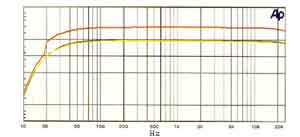AOpen AX4GE Tube-G
Review by Harry Lam
on 03.13.03
Motherboard provided by AOpen
Audio Quality:
The tube design on the AX4B-533 and the AX4GE Tube-G are very similar, despite the fact that the circuit design differs slightly. However, the two designs both have their own distinct sound. You have to note that since each vacuum tube can only amplify two outputs, the design on the AX4B-533 and the AX4GE Tube-G only will use the vacuum tube to amplify the front left and right speakers. The rear, center, and subwoofer speakers are amplified via the traditional method.
I hooked up both the AX4B-533 and the AX4GE Tube-G to my Logitech Z-560 system. Since this isn't a 5.1 surround system, it only has two connectors (for front and rear channels). I left the rear speakers disconnected, turned off M3D, and turned the bass up to 1/3 of max. In Windows, both the master and wave volume were turned up to 3/4 of max, and bass/treble were left at default (which were actually disabled). For my music quality comparisons, I switched between the between the Front Speaker Out and the Rear Speaker Out jacks (as Winamp3 outputs music to all 4 speakers, at equal levels) in middle of songs; often repeating the exact same segment in a song right after switching outputs.
The digitally amplified output was a bit louder than the TubeSound, which made a direct comparison somewhat harder than I expected. I did not adjust volumes when comparing between the outputs, but rather left it at the same settings.
My first reaction to the TubeSound audio was the fullness of the tone as well as the more realistic nature of the audio. I did notice that certain supporting instruments in the midrange aren't brought out as nicely and tend to get overpowered by other tones. Despite this the sound from the tubsound output is richer and blends much better in comparison to the solid state output. The bass on the TubeSound isn't nearly as powerful as the traditional output, but the beat was much more crisp and less distorted. In gaming, the TubeSound added an additional aspect of realism, but the difference wasn't as distinct as I noticed while listening to music. I noticed that the TubeSound especially shined in songs featuring guitars, with each note sounding incredibly realistic without any of the "tin can" sensation that can be found in certain recordings. In piano music, the TubeSound really brought out the force behind each note, sounding closer and closer to a live real piano. When I switched over to songs featuring female vocals, I was really amazed at the depth of the audio.
In my own listening experience, the TubeSound really excels at classical, pop, jazz, and rock music. For other genres and applications, the difference wasn't as drastic, however, there was always a positive improvement over the traditional sound output.
I also polled a few of my friends on a single blind test, and they all chose the tube amplified output over the traditional output. Simply put, the audio quality on the TubeSound motherboards is sensational (and I'm quite sure it could be even better if they had a higher quality solid-state audio chipset).
Frequency Response:
AOpen includes an extra little manual for the TubeSound portion of their motherboard, with background information on the design, vacuum tube selection, and maximizing your audio enjoyment.
Frequency response details the range of audio frequencies in which a device can produce. Basically, when audio is amplified (from the input to the output), the input and output waveforms differ by magnitude (the loudness) and phase (which in a sense is the delay of an audio tone in relation to the original). Frequency response consists of the differences in magnitude and phase between the input and output waveforms. In layman's terms, basically, you want a frequency response graph to be as flat (linear) as possible.
I basically scanned in the two frequency response curves from the two TubeSound manuals and superimposed them on top of each other (keeping the frequency scale the same).
 |
| Red: AX4B-533, Yellow: AX4GE/PE |
The primary comparison between the two graphs is the overall flatness of the curve. The graphs range from 10Hz to approximately 20kHz (just for reference 20Hz-20kHz is the hearing range of a normal human). The two graphs are relatively similar, both having a very linear region from about 30Hz to past 20KHz.
Note that a product can boast a very high frequency response (in terms of the range covered), but yet possess horrible audio quality (with a graph that is not very flat). Hence, you can have a cheap pair of PC speakers boasting a 20Hz-20KHz frequency response, but an expensive audiophile set of speakers only boasting 38Hz-20Hz. The range of frequency response isn't the only factor in the audio quality of a product, but other factors such as THD, the flatness of the frequency response curve, etc should also be taken into account.
| « Previous Page | Next Page » |

